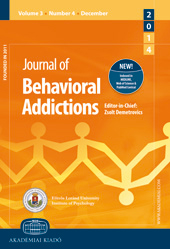Differential Effects of Reward Drive and Rash Impulsivity on the Consumption of a Range of Hedonic Stimuli
Differential Effects of Reward Drive and Rash Impulsivity on the Consumption of a Range of Hedonic Stimuli
Author(s): Belinda C. Goodwin, Matthew Browne, Matthew J. Rockloff, Natalie LoxtonSubject(s): Individual Psychology, Cognitive Psychology, Behaviorism, Substance abuse and addiction, Health and medicine and law, Socio-Economic Research
Published by: Akadémiai Kiadó
Keywords: reward drive; rash impulsivity; consumption; health behavior; hedonic stimuli;
Summary/Abstract: Impulsivity has consistently been associated with over-consumption and addiction. Recent research has reconceptualized impulsivity as a two-dimensional construct (Dawe, Gullo, & Loxton, 2004). This study explores the relationship of the two components of impulsivity, reward drive (RD) and rash impulsivity (RI), on a broad group of 23 hedonic consumption behaviors (e.g., gambling, substance use, eating, and media use). We tentatively grouped the behaviors into three descriptive classes: entertainment, foodstuffs, and illicit activities and substances. Results: RD and RI positively predicted elevated levels of consumption in a community sample (N = 5,391; 51% female), for the vast majority of the behaviors considered. However, the effect sizes for RD and RI varied significantly depending on the behavior; a pattern that appeared to be at least partially attributable to the class of consumption. Results support the view that RD is related more strongly to the consumption of products that provide social engagement or a sense of increased status; whereas RI better reflects an approach toward illicit or restricted products that are intensely rewarding with clear negative consequences. Discussion and conclusion: Results support the utility of the two-factor model of impulsivity in explaining individual differences in patterns of hedonic consumption in the general population. We discuss findings in terms of strengthening current conceptualizations of RI and RD as having distinct implications with respect to health-related behaviors.
Journal: Journal of Behavioral Addictions
- Issue Year: 5/2016
- Issue No: 2
- Page Range: 192-203
- Page Count: 12
- Language: English

